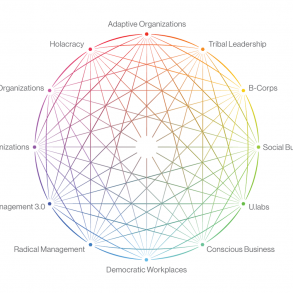By Rich Decibels and originally published at leanpub.com
Note from Enlivening Edge Magazine: This is the Introduction to a book being written.
Introductions
95% done
What’s the sound of a humming team?
This is a book about working in groups. I’m not so interested in what you’re working on together, I’m just going to focus on how you do it.
To my way of thinking, it doesn’t matter if you’re trying to build a better electric vehicle, or develop government policy, or care for sick people, or blockade a pipeline; whenever you work with a group of people on a shared objective, there’s some stuff you’re going to deal with, some challenges. How do we decide what we’re working on? who does what? who can join our team? what are our expectations for each other? what happens when someone doesn’t fulfil those expectations? what do we do with disagreement? how do decisions get made?
A hierarchical management structure is one way to deal with the challenges of working together. There’s a boss at the top who calls the shots, they delegate some limited responsibilities down a ladder of managers, and the managers eventually pass a very small parcel of responsibility to the workers at the bottom of the pyramid.
I don’t really know anything about working in traditional hierarchies.
This is a book for people who are trying to organise in a different way, for groups who want less hierarchy and more collaboration. There’s not really a great word for it: self-organising, bottom-up, self-managing, horizontal, sociocratic, heterarchical, teal, cooperative, non-hierarchical…
I call it “decentralised organising” because I’m thinking of a network of relationships with no central point of power and control, no single point of failure. All the contributors have different areas of focus, different degrees of commitment or experience, but that difference sits on top of a strong foundation of equality: everyone’s voice is equally valued, everyone is equally entitled to dignity and respect. It’s more about fairness than sameness. A decentralised group is nimble, supple, limber: people adjust to each other and to the changing environment. Good ideas can come from anywhere, and no one person is irreplaceable.
Have you ever had an experience working with other people where it just felt easy? Everyone is playing to their strengths. There’s not a huge amount of process or formality getting in the way. Together you’re flexible and adaptable but not chaotic. You know when to take initiative, and when to stop and ask for input.
You’ve got room to stretch and grow, but you can have an “off day” without feeling like you’re letting people down. You’re getting stuff done and having fun at the same time. Most of us have had glimpses of a way of working together that feels delightful, easy, productive, fun. When I say “a humming team”, most people know what I’m talking about. So I want to know, what does that hum sound like?
I’m convinced there is not a “one size fits all” recipe, a management structure that you can take off the shelf and install in your collective or your company.
But my hypothesis is that there are patterns: common design elements you can draw on as you construct a recipe that’s right for you. Each pattern in this book names a challenge that you are likely to face, and offers tools and techniques you can try in response to that challenge.
In essence, I’m mostly drawing from three schools of thought: Agile software development (work in rhythm, develop peer accountability, talk about your problems and co-design solutions together), feminism (account for affective labour and distribute it fairly), and anarchism (consent, autonomy and mutual aid as first principles, combined with an honest and persistent appraisal of power). This is not a book about ideas though, it’s very practical, straightforward, grounded in direct experience, and ready to be applied in your team right away.
You can read the sections in any order, so if you want to get straight into it, skip ahead to the Patterns now. Or if you want to know more about me and where I am coming from, read on…
Republished with permission of the author who gives credit to Loomio and Enspiral for support.
Featured Image/graphic link and block quoting added by Enlivening Edge Magazine.




